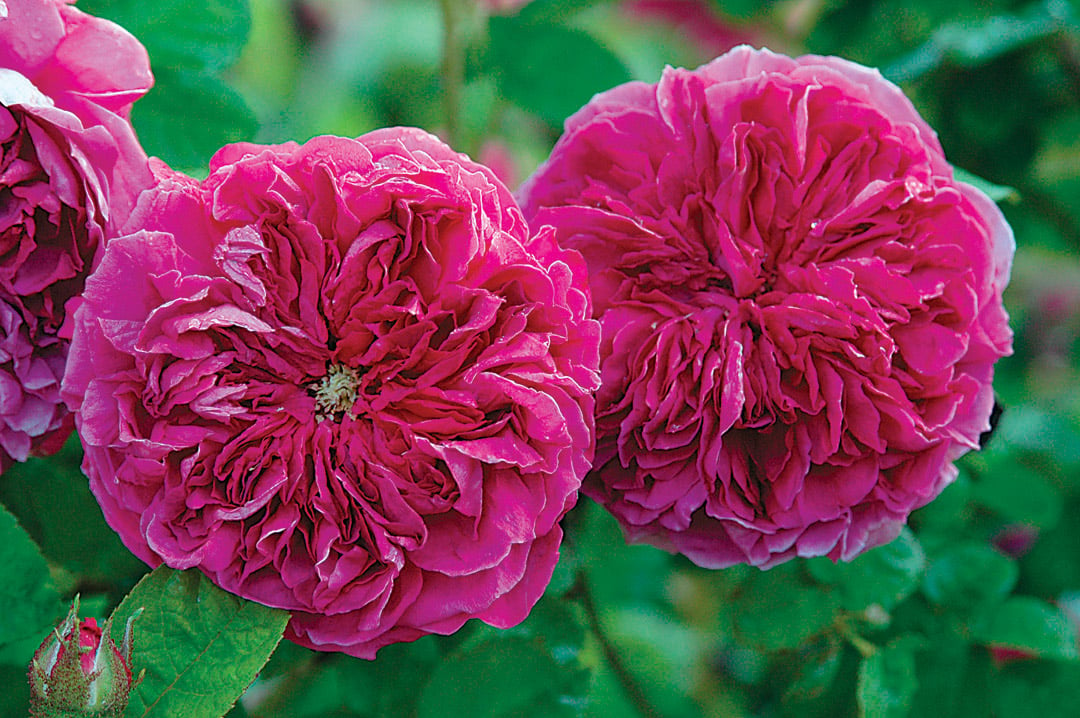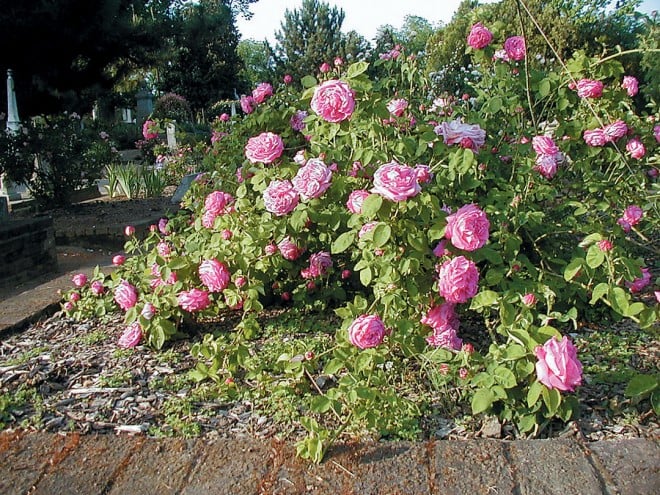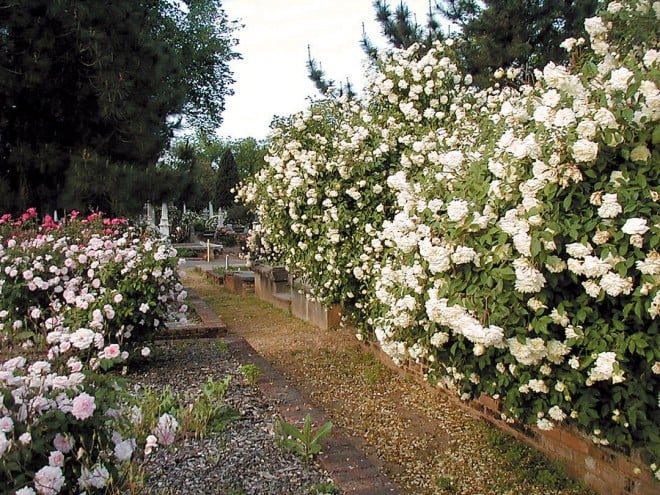
Sacramento’s Historic Rose Garden

Contributor

The yellow flowers of the hybrid musk rose ‘Buff Beauty’ frame a headstone at the Old City Cemetery in Sacramento. Rosa x odorata has snaked its thorny branches high into a towering cedar and, every spring, drips weeping swags of white flowers from its dark green branches.
Nearby, a Banks rose, Rosa banksiae var. normalis, scrambles sixty feet into a pine tree. The apothecary’s rose (R. gallica var. officinalis) spills over a low brick wall while ‘Lavender Lassie’ crawls over a metal framework, forming a tunnel of lavender pink blossoms. ‘Sally Holmes’ carpets the ground with its off-white petals, and ‘Duchesse de Brabant’ sits covered in blowsy, satin pink flowers.
Some 400 heritage roses, part of the Historic Rose Garden, lay nestled among the towering pines, cedars, and elms in the oldest part of Sacramento’s Old City Cemetery. Their heritage is as old as the cemetery itself, many of them dating back to the early and mid-1800s. There are ramblers and climbers as well as shrubs. Unlike the modern hybrid teas that gardeners so often slash to knee-height every year, these mighty roses have been allowed to spread their thorny branches widely. They insinuate themselves among the perennials. Some rise up out of their beds, towering over iris, snapdragons, asters, daffodils, and crocus; others spill politely into paths, and lie snugly against low brick walls and weathered tombstones. Many produce an abundance of flowers in late spring and early summer, then repeat sporadically throughout the year; others seem always to be in bloom. No matter the season, some of these obliging, carefree treasures will be producing flowers. They grow in a variety of shapes and sizes, and blend well with perennials, shrubs, and trees in the landscape. With exotic and romantic names such as ‘Rêve d’Or’, ‘Souvenir de la Malmaison’, ‘Mme Lombard’, the sweetbrier or eglantine rose (Rosa rubiginosa), ‘Cramoisi Superieur’, ‘La Reine’, ‘Maman Cochet’, and ‘Sombreuil’, they are the roses grown in centuries past by the likes of Empress Josephine of France, and captured on canvas by the eighteenth-century artist Pierre-Joseph Redouté. Here in Sacramento, they make a gloriously scented haven among the old tombstones and carriageways through the cemetery. Generally cultivated between 1849 and 1915, the majority of these roses are vigorous and hardy. As Barbara Oliva, curator of the collection, describes them: They were popular during those years, they were planted in cemeteries, and they could and did survive a lot of neglect. Many endured long sea voyages or were brought along on rigorous trips across country in covered wagons. These roses are tough. Some, like the Gallicas, date much earlier, but they were popular cemetery roses in California. The collection also contains hybrid perpetuals, hybrid musks, and polyanthas, but Oliva draws the line at the older cultivars. “We have a few hybrid teas, but they are the earliest ones and don’t look anything like the modern hybrid teas.”
The cemetery is steeped in Sacramento history. More than 20,000 pioneers are buried there, including many eminent Californians like John Sutter, Mark Hopkins, and Judge EB Crocker. It dates back to 1849, when it was called the public graveyard. Many of the tombstones are so worn that they are no longer readable. The plots are privately owned, although many no longer have relatives to maintain them.
Rosarian Jeri Jennings, founder of the Gold Coast Heritage Rose Group in Ventura and Santa Barbara counties, doesn’t mince words when talking about the collection of roses at the Old City Cemetery: The Historic Rose Garden is probably one of the best cemetery heritage rose gardens in the nation. I’ve visited others around the country, and none of them match up to the rose garden in the Sacramento cemetery. They don’t even come close. It’s an incredible treasure.
It didn’t always look this way, according to Oliva, an admittedly accidental rosarian: [Fifteen years ago,] this part of the cemetery was in ruins. It was an unkempt, neglected weedy patch. You could hardly walk along the paths for all the weeds. The milkweed was upwards of seven or eight feet tall. Many of the brick walls around the burial plots were crumbling. Headstones had been toppled or broken. There were a few good old roses that had survived, but barely. It was really sad.

A Generous Gift
The site had possibilities, though. There was plenty of sunshine to ensure roses would bloom profusely, yet enough afternoon shade to prevent them from scorching in Sacramento’s blazing summers. So when world-renowned rosarian Fred Boutin offered to donate a collection of sixty-four heritage roses to the Sacramento group, they worked to secure the land at the top of the cemetery, and started planting the roses that would transform it from a derelict tangle of weeds into a rose garden of uncommon beauty. Other heritage rose aficionados, including Jean Travis, Stuart Lauters, Sherry Berglund, Cass Bernstein, and Carl Luhn, donated additional roses to the collection. Many more were collected from old ranches and cemeteries in California.
At that time, Barbara Oliva was just beginning to learn about these horticultural antiques, but she pitched in to help plant Boutin’s roses. She was already an enthusiastic gardener, and grew her share of camellias and azaleas like many Sacramento gardeners. With a bit of embarrassment in her voice, she admits growing a few hybrid teas. “The old roses began creeping in after I read about them in a magazine. I read a description of ‘Austrian Copper’ (Rosa foetida var. bicolor), and I had to have it.” Soon, her typical suburban garden became a California-flavored English border (without the lawn). More and more old roses began to appear in the garden, and she found herself drawn deeper and deeper into the world of heritage roses. One day, she realized that she was single-handedly overseeing their care at the cemetery. “It wasn’t anything I anticipated, even as I worked into it. The job just kept growing, like topsy.”
A retired schoolteacher and daughter of a Presbyterian minister, Oliva has managed to assemble a significant collection of rare, exotic, and diverse old roses in the cemetery. The garden now covers about two acres and encompasses roughly 200 family plots. She estimates that she volunteers eighty to one hundred hours a month in the cemetery rose garden, overseeing a small cadre of volunteers. She organizes garden activities in the cemetery, runs workshops, recruits volunteers, and coordinates garden maintenance with crews from the Sheriff’s Department and the City of Sacramento. She prunes, weeds, and deadheads plants as she can. “My back gets grumpy, so when it starts grumbling, I quit.” She’s also a popular speaker with garden clubs who want to learn about heritage roses, and regularly gives demonstrations on pruning roses.
With a mischievous gleam in her eyes, a friendly smile, an ambling walk, and a gentle demeanor, Oliva is likely to be found wandering among the roses in all but the most severe weather. She knows all the roses by name, and can tell you when they were planted, who donated them, or where they were found. She can tell at a glance which need trimming, which are looking exceptionally fine, and which could use some attention.

An Ongoing Search
Always on the lookout for heritage roses, Oliva and other rose enthusiasts from throughout California regularly scour old cemeteries, back roads, and abandoned homesteads for old-fashioned roses. They hope to discover some of the hundreds of exotic beauties lost to cultivation, those alive only in the pages of dusty old tomes or in the memories of rosarians and artists from centuries past. Her goal is to collect heritage roses lost to cultivation, then to take cuttings and share them with heritage rose nurseries.
Many of the roses in the collection are what Oliva calls “found” roses. “They are definitely heritage roses,” Oliva said, “but no one knows their true identity.” She and her volunteers give them working names that reflect what the rose looks like or where it was found. Often visiting rosarians can identify the roses. Oliva remembers a rose she found growing in a pasture that the group affectionately called Barbara’s pasture rose. It was recently identified as Rosa ‘La Reine.’ Some, admittedly, are never identified.
Since the Historic Rose Garden was planted, other groups have come into the cemetery to plant gardens. Members of Sacramento’s Perennial Plant Club tend a large perennial garden in part of the cemetery called Hamilton Square (see Pacific Horticulture, April 2007), and the local chapter of the California Native Plant Society has planted a garden of natives. Over the years, Boy Scout groups have come in to wash tombstones. Oliva is always looking for new volunteers to help with pruning and planting.
Standing in the rose garden on a recent sunny day, Oliva surveys the rose bushes that surround her. Using her hand to shade her eyes, she smiles at the bounty of rose blossoms before her. Surrounded by hundreds of years of California history, politics, romance, and intrigue, she knows the roses she helped establish may be the very ones these pioneer families planted and enjoyed in their lives, too.

Old Fashioned Roses
Aficionados call them heritage roses, old fashioned roses, even old garden roses. They are the hundreds of varieties of roses found in gardens in the 1800s and early 1900s. The main categories of old roses are: albas, Bourbons, centifolias, Chinas, damasks, Gallicas, hybrid musks, hybrid perpetuals, moss, and Noisette. What they have in common is a reputation for being tough, hardy, and resistant to disease.
“Unlike the modern hybrid tea, the flowers have a definite ‘old-fashioned’ look as well as a romantic appeal to gardeners,” according to Barbara Oliva, curator of the Historic Rose Garden at Sacramento’s Old City Cemetery. The plants can be climbers, ramblers, or shrubs. Some made lanky bushes to ten or more feet across. Others sent suckers far and wide, gobbling up the garden. Flowers were single, semi-double, quartered, cupped, and often tightly packed. They were a bit on the wild side, but mixed gracefully with other plants in the garden. Most of them bloomed only once in the spring and were heavily scented, although many others bloom sporadically throughout the year, or again in the fall. Some produce masses of flowers all in a cluster while others bloom all along the branches.
As Oliva puts it, “Mention hybrid tea and you immediately visualize a basic picture. The heritage roses almost defy description because they are such a diverse group, but that’s what attracted me. There are so many flower forms, so many plant forms and such interesting plants. Many of the flowers are fragrant, but what grabs me is they don’t fall into one category.”
Barbara’s Top Picks:
Oliva pauses, then smiles, when asked to make a list of her favorite heritage roses. “My favorite is the one in front of me at this moment,” she likes to say. Still, when pushed for a sure-fire list for Central Valley gardens, she has these suggestions:
‘Duchesse de Brabant’: a tea rose with soft pink, double-cupped blowzy flowers. The outer petals are flushed with salmon. The leaves are light green, and the bush is slow growing to about four feet tall. This was Teddy Roosevelt’s favorite rose; he used to wear a flower in his lapel. “It’s almost constantly in bloom, has a nice fragrance, and is an orderly plant that doesn’t get monstrous in the garden.”
White pearl in red dragon’s mouth: also called Chi Long Han Zhu. “The name describes the flower beautifully. This one is really old.”
‘La Reine’: a hybrid perpetual offering medium pink, globular flowers. Introduced from France 150 years ago, it makes a good cut flower and has a long blooming season, often flowering again later in the season. “I love the complex flowers of the hybrid perpetuals. That’s what attracted me to old roses in the first place.”
‘Mme Isaac Pereire’: a Bourbon, its large, deep pink flowers are wonderfully fragrant. It grows to seven feet tall, with lots of prickles and deep green leaves.

‘Reine des Violettes’: another hybrid perpetual, this flowers in summer and again in the fall, with a nice fragrance. A medium sized shrub, it is almost thornless, but a tough, vigorous plant. “Whenever there was a lot of hooplah about a blue rose, Graham Stuart Thomas would stick this one in his lapel and everyone would stop talking. It’s definitely on the blue side.”
‘Perle d’Or’: a polyantha, also called a China rose or a yellow ‘Cécile Brünner’. With a fruity fragrance, its petals curve out a bit. It blooms constantly. “It’s vigorous and happy in the Sacramento Valley. For anyone who loves ‘Cécile Brünner’, this is a better choice.”
‘Veilchenblau’: a rambler and once bloomer, but if there’s room in the garden for once bloomers like azaleas and camellias, then why not for a grand rose like this one? It is almost thornless, with semidouble flowers of violet streaked with white.

Rosa ‘Barbara Oliva’
Barbara Oliva remembers clearly the conversation she had with Paul Barden, of The Uncommon Rose, when he decided to name a rose for her. “He described the rose, a moss seedling, and I started purring with delight. I asked him the name of the rose, and he said ‘How about ‘Barbara Oliva?’ ‘I was speechless.” Rosa ‘Barbara Oliva’ is an old-fashioned mosstype rose. Its sepals are covered in sticky, fragrant mossing. It makes a compact, yet lush shrub with arching canes. The fragrant flowers start a pink purple color and change to a dusky mauve as they age. It blooms for several weeks in early summer.
Share:
Social Media
Garden Futurist Podcast
Most Popular
Videos
Topics
Related Posts

Ground Up Science for Greener Cities with Garden Futurist Dr. Alessandro Ossola
Spring 2023 Listen to the Podcast here. Alessandro Ossola is a scientist who gets very excited about the challenge of climate change allowing for an

Readying Urban Forests for Climate Realities with Garden Futurist Dr. Greg McPherson
Winter 2023 Listen to the Podcast here. “Going from the mow and blow to a more horticulturally knowledgeable approach to maintaining the landscape. And that

Low Maintenance Gardens – Better for Pollinators and People
Autumn 2022 “I come out every day. It’s therapy, my meditation.” Janet’s young garden transformed from overgrown, invasive plants to mostly natives. The dailiness of

Calochortophilia: A Californian’s Love Affair with a Genus
Summer 2022 I can chart the progression of my life by Calochortus. For the last two decades, at least. As a teenage girl growing up










Responses